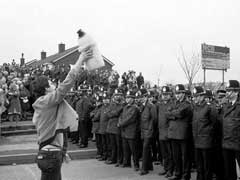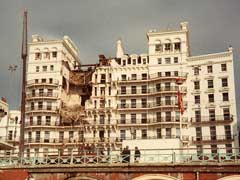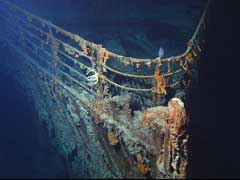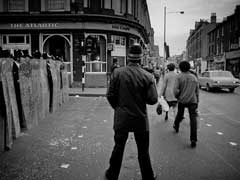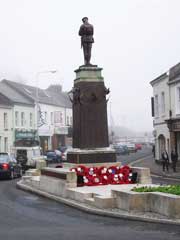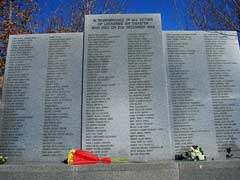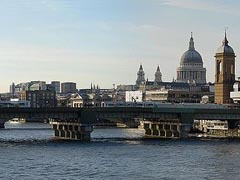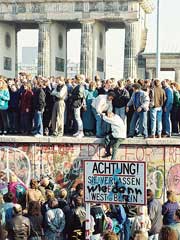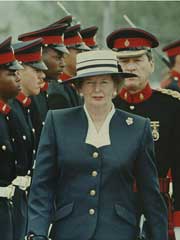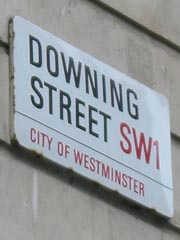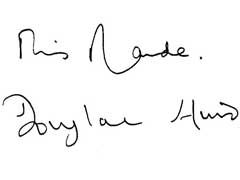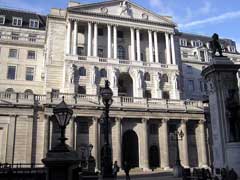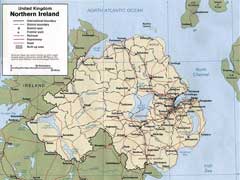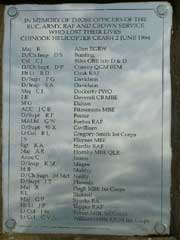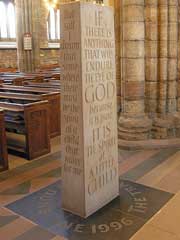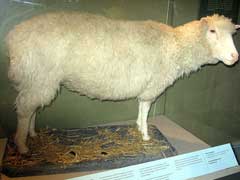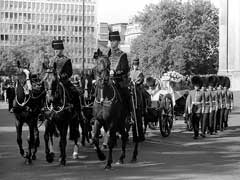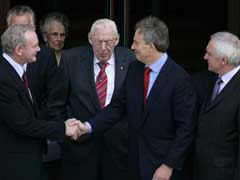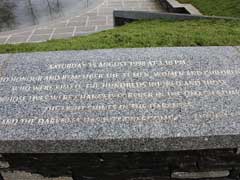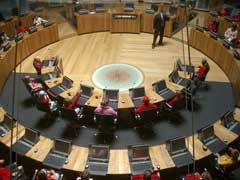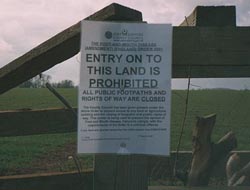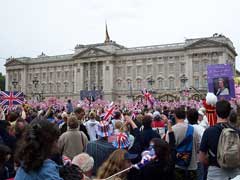In 2013 the government began its move towards releasing records when they are 20 years old, instead of 30. During 2013 The National Archives received records from 1983 and 1984, and in 2014 records from 1985 and 1986. Two further years’ worth of government records are being transferred to us each year until 2022 when we will receive the records from 2001 and 2002.
-
March 1984
Miner
The National Union of Mineworkers (NUM) gives official backing to an indefinite strike of 70,000 men. The strike lasts one year, ending in March 1985.
October 1984
IRA bomb the Conservative Party Conference in Brighton
An IRA bomb explodes at the Grand Hotel, Brighton during a Conservative Party Conference, killing four people.
-
September 1985
Wreck of RMS Titanic found
The wreck of RMS Titanic is located. The first photos and films are taken 73 years after it sank.
September 1985
Riots in Birmingham and London
Rioting starts in Birmingham and later in Brixton after the shooting of a black woman during a police search of her house. The unrest breaks out later on the Broadwater Farm Estate in Tottenham, resulting in the death of a police officer.
Image attributed to Kim Aldis
-
April 1986
John McCarthy kidnapped
Journalist John McCarthy is kidnapped during the Lebanon hostage crisis. Church of England envoy, Terry Waite, is kidnapped in January 1987 while negotiating for his release. They are both eventually freed in 1991.
Image attributed to FunkMonk
October 1986
AIDS health campaign launched
The Government launches a £20m campaign to warn about the dangers of AIDS.
-
October 1987
Black Monday
Wall Street crash wipes £50bn off the value of shares on the London Stock Exchange.
November 1987
Remembrance Day bombing
11 people are killed by an IRA bomb at a Remembrance Day service in Enniskillen, Northern Ireland.
Image attributed to Dean Molyneaux
-
July 1988
Piper Alpha oil rig disaster
An explosion on the North Sea oil rig Piper Alpha kills 170 people.
Image attributed to Elliott Simpson
November 1988
Lockerbie bombing
Pan Am Flight 103 explodes over the Scottish town of Lockerbie, killing 270 people, including 11 inhabitants.
Image attributed to Dean Molyneaux
-
August 1989
Marchioness disaster
The pleasure boat, the Marchioness, sinks in the River Thames after colliding with a barge, killing 51 people.
November 1989
Fall of the Berlin Wall
The demolition of the Berlin Wall marks the beginning of the end of the Cold War.
Image attributed to Sue Ream
-
May 1990
France bans imports of British beef
France bans British beef and live cattle imports over fears of Bovine Spongiform Encephalopathy (BSE), commonly known as mad cow disease.
November 1990
Margaret Thatcher resigns
Margaret Thatcher fails to win an outright victory in a leadership contest and resigns as leader of the Conservative Party and Prime Minister. John Major succeeds her.
Image attributed to Jay Galvin
-
January 1991
Gulf War begins
The Gulf War begins with the aerial bombardment of Iraq.
February 1991
10 Downing Street attacked
The Provisional IRA launch a mortar bomb attack on 10 Downing Street while the Cabinet is in session.
-
February 1992
Maastricht Treaty signed
The signing of the Maastricht Treaty creates the European Union and paves the way for the creation of a single European currency.
September 1992
Black Wednesday
The government suspends Britain
-
April 1993
Murder of Stephen Lawrence
Black teenager Stephen Lawrence is murdered while waiting for a bus on the evening of 22 April 1993.
December 1993
UK and Irish governments sign declaration
The Downing Street Declaration is signed by the UK and Irish governments to promote talks on the future of Northern Ireland.
-
June 1994
Chinook helicopter crash
A Chinook helicopter crashes in the Mull of Kintyre killing 29 people.
July 1994
Tony Blair becomes Leader of the Labour Party, following the death of John Smith
Tony Blair wins the Labour leadership contest and becomes Leader of the Labour Party, following the death of John Smith.
-
February 1995
Barings Bank collapses
Barings merchant bank goes into receivership following heavy losses in its Singapore Office.
July 1995
War in Bosnia and Herzegovina begins
British forces are sent to Sarajevo to help relieve the long-running siege in the city.
-
March 1996
Dunblane massacre
A gunman kills 16 children, their teacher and himself at a primary school in Dunblane, Scotland.
July 1996
First successfully cloned mammal in UK
Dolly the sheep is the first mammal cloned from an adult cell, rather than being conceived naturally. This opened up the ethnical debate on genetic engineering.
-
May 1997
Labour win general election
Tony Blair wins a landslide general election and becomes Prime Minister.
August 1997
Princess Diana dies in car crash
Diana Princess of Wales and Dodi Fayed die in a car crash in Paris after being chased by paparazzi.
-
April 1998
Good Friday Agreement signed
The agreement marks a major political development in the Northern Ireland peace process.
August 1998
Omagh bombing
Opposed to the Good Friday Agreement, the Real IRA bomb the town of Omagh, killing 29 people.
-
January 1999
The Euro is launched
The European single currency, the Euro, becomes the new official currency of 11 Member states.
May 1999
Scottish and Welsh elections
The first elections to the new Scottish Parliament and Welsh Assembly are held, following a referendum to devolve some powers to respective governments in 1997.
-
January 2000
Millennium Dome opens
The Millennium Dome was commissioned to house an exhibition celebrating the beginning of the third millennium. Although the original exhibition was dismantled, the structure is now used as a popular music venue.
October 2000
Hatfield rail crash
A train derails south of Hatfield station, killing four people.
-
February 2001
Foot and mouth disease
Foot and mouth disease is detected in British herds, prompting a mass slaughter of animals as a precautionary measure.
September 2001
9/11
The Islamist militant group al-Qaeda hijack four passenger planes, crashing two into New York’s World Trade Centre, and killing nearly 3,000 people. This instigated the war in Afghanistan, which begins in October.
Image courtesy of the Prints and Photographs Division, Library of Congress
-
April 2002
Queen Elizabeth II celebrates the Golden Jubilee
The Queen addresses Parliament in a speech marking 50 years on the throne. This follows a difficult year that saw the deaths of both her sister, Princess Margaret, and the Queen mother.
May 2002
Potters Bar rail crash
A train derails at Potters bar, killing seven people.
Image attributed to Nigel Cox
What’s changed?
The Public Records Act requires central government departments, and certain other public bodies, to identify records of historical value and transfer them for permanent preservation to The National Archives, or to another appointed place of deposit, by the time they are 30 years old. The Government is reducing this timeframe from 30 to 20 years.
This is a major change and one that is being introduced in a manageable and affordable way, using a phased approach. The first phase began in 2013 and applied to the government departments and other bodies that transfer records to The National Archives. It also applies to the bodies that are places of deposit for their own records, such as the Tate Gallery, and to specialist collecting archives such as the Imperial War Museum.
Two years’ worth of government records will be transferred to us each year until 2022. From then on a single year’s worth of records that are 20 years old will be transferred. The transition to a 20-year-rule will take place over ten years and we are publishing data on the volume and transfer status of the records held by those bodies that transfer to us on our website.
The second phase – records of local interest
From 1 January 2015, transition to the new rule began for records of specified bodies transferring records to local places of deposit. Records within this category are primarily of local interest and include those created by Magistrates’ courts and the NHS. Find out more about the 20-year rule for records of local interest.
When these records are transferred to The National Archives or another place of deposit they are usually ‘open’ and available for public access. This is because some of the exemptions in the Freedom of Information Act, which provide the grounds for ‘closing’ records, fall away at the same time. The government has also decided to bring forward, from 30 to 20 years, the point at which some of these exemptions fall away so that these transferred records are routinely available for public access.
Useful links
Read more about the history of the Public Records Act and how it works with other related legislation to underpin how the public record is managed.
A review of the 30-year rule was commissioned by the government in 2007. The findings of the review were published in a report in 2009.
